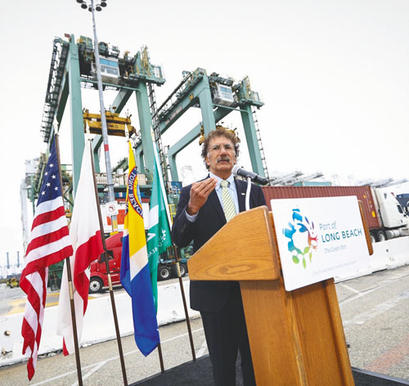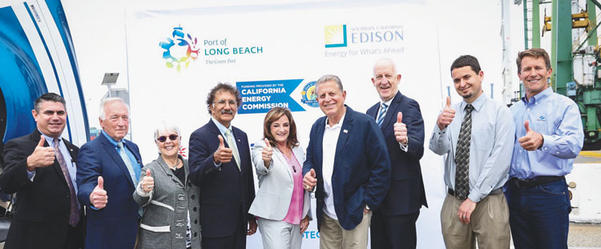Officials from the Port of Long Beach, Southern California Edison (SCE) and the California Energy Commission launched a pilot project on April 4 to test zero-emissions terminal equipment at the Pacific Container Terminal, one of three terminals included in the program.

Port of Long Beach Executive Director Mario Cordero speaks during the Zero-Emissions Terminal Transition Project launch event on April 4. The project includes transitioning 25 cargo-handling vehicles to zero emission to test their performance in a real-world setting. (Photograph courtesy of the Port of Long Beach)
“The Zero-Emissions Terminal Transition Project kicks off a new era in transportation electrification and the port’s own transformation to zero emissions,” Long Beach Harbor Commission President Lou Anne Bynum said during the launch event. “We are grateful for the partnerships with the Energy Commission and Southern California Edison that are making this a reality.”
The project is the nation’s largest zero-emissions pilot for cargo handling equipment for seaports. Under the project, zero-emissions equipment such as cranes and vehicles will be in use for one year to “test their performance in a real-world setting,” according to a port press release. Nine diesel-electric rubber tire gantry cranes will be converted into fully electric equipment at one terminal, while two other terminals will receive 12 battery-electric yard tractors. Four liquefied natural gas trucks will also be converted into plug-in hybrid trucks for a drayage trucking firm that operates within the terminals.

The Port of Long Beach (POLB) and its partners celebrated the launch of the “nation’s largest zero-emission pilot for cargo handling equipment for seaports” on April 4. Pictured from left: POLB Managing Director of Planning and Environmental Affairs Rick Cameron; Vice President of SSA Marine Paul Gagnon; Harbor Commissioner Bonnie Lowenthal; POLB Executive Director Mario Cordero; Harbor Commission President Lou Anne Bynum; Harbor Commissioner Frank Colonna; Southern California Edison President Ron Nichols; Sam Lerman, California Energy Commission; and Greg Roche, Clean Energy Fuels. (Photograph courtesy of the Port of Long Beach)
The project is a direct result of the San Pedro Bay ports’ 2017 approval of an updated Clean Air Action Plan, which set the goal of all terminal equipment being converted to zero-emissions technology by 2030.
“The projects we are kicking off today will help to address some of Southern California’s biggest challenges – cleaning up the air and reducing harmful greenhouse gases that cause climate change,” SCE President Ron Nichols said. “SCE’s vision for a clean energy future means partnering with the port and other SCE customers to electrify transportation, as well as working hard to make sure the electricity that we provide to power those vehicles is produced with clean, renewable resources.”
The port anticipates the project will reduce greenhouse gases more than 1,323 tons and nitrogen oxides by 27 tons annually. The transition will also save an estimated 270,000 gallons of diesel fuel. The zero-emissions port project is mostly funded by a $9.7 million grant from the California Energy Commission.
